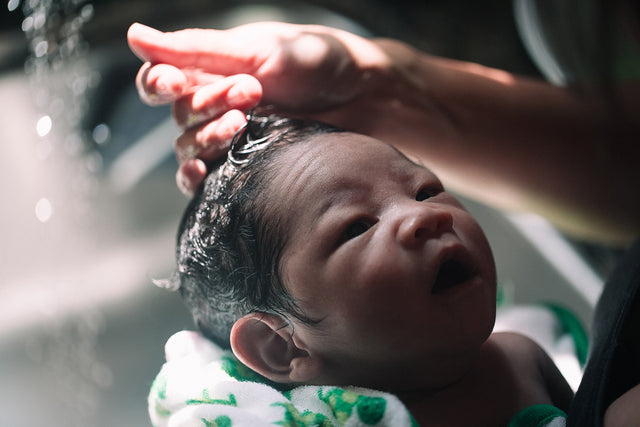Get Rid of Cradle Cap With This Proven Method

Uh-oh. Is your newborn’s adorable, kissable head looking a little…scaly?
What is cradle cap?
As early as a few weeks old, many babies start showing greasy, thick, crusty, or flaky scales on their scalp, forehead, eyebrows, or even their ears. The scales can be yellow, white, or brown, and the skin might be a little red. This is cradle cap—or seborrheic dermatitis—and yes, it can be pretty icky. But there’s good news:
-
It’s harmless. It’s not a sign of infection, allergy, or eczema. And it’s not painful. (But it can definitely be itchy, causing some infants to rub or scratch their forehead with their hands…or to rub their face into a sheet.)
-
It’s not contagious. Babies can’t pass cradle cap to one another.
-
It’s no biggie. Babies tend to get it on the eyebrows or soft spot. Why? Because parents are a little hesitant to scrub these sensitive areas.
-
It won’t last forever. It’ll go away within 1-2 weeks after you address it.
What causes cradle cap?
Many parents think that cradle cap is just dry skin. Cradle cap looks like dry skin, but it’s actually flakes of dead skin stuck together with the natural oil from your baby’s pores. Those yucky scales are just dead skin trapped in extra oil that’s stuck to the scalp like a bunch of postage stamps stuck on a package. In the removal process, you’re trying to float those postage stickers up—so that you can wash them off.
How to get rid of cradle cap:
-
Massage oil into your baby’s scalp. I recommend using coconut oil, or cocoa butter. They’re natural and easy to find at stores.
-
Let it sit for a few minutes. The oil will soften and dissolve the cradle cap so that the dead skin can “float up” off the scalp.
-
Apply a mild, baby shampoo. You’ve got to get rid of the excess oil…and shampoo will do the trick.
-
Gently scrub. With the shampoo still in, you’ll want to use a gentle baby brush or a soft-bristled toothbrush to free the dead skin. Try not to pick or scratch.
-
Rinse thoroughly with water. And say goodbye to cradle cap as the gunk and suds go down the drain!
-
Use dandruff shampoo as a last resort. If our treatment doesn’t take care of it, ask your doctor if you should try an anti-dandruff shampoo or cortisone lotion. But don’t turn to these first—they can irritate your baby’s sensitive skin.
Cradle cap…on your baby’s bum?
In some cases, cradle cap might even extend to your baby’s bottom. You might mistake it for diaper rash, and it’s best to treat it the same way: Keep the skin clean and dry, use plain water or mild wipes, and apply a gentle diaper cream or lotion. But since so many things can cause a diaper rash, it’s best to ask your doctor.
Don’t make this cradle cap mistake!
Many parents think they should apply oil to their baby’s scalp as a preventative remedy—they get fooled by its dry appearance and think oil will help. But since excess oil is the cause, that’s one of the worst things to do. So, once you get rid of cradle cap, think of it like starting from a clean slate—that you’ll want to keep clean. Wash your infant’s hair and face regularly to keep excess oil from building up.
And buck up your courage to gently, yet thoroughly, clean around the eyebrows and sensitive soft spot!